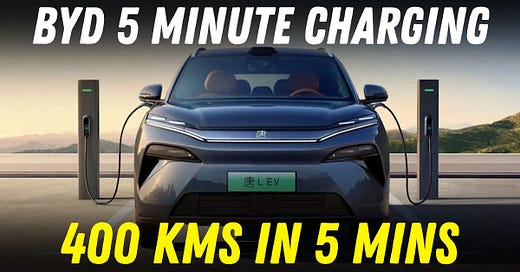The electric vehicle (EV) landscape is evolving at breakneck speed, and Chinese automaker BYD is once again at the forefront of innovation. In March 2025, BYD unveiled its groundbreaking "Super e-Platform," a charging system that promises to deliver 400 kilometers (approximately 250 miles) of range in just five minutes. This development could redefine the EV industry, addressing the biggest hurdles to widespread adoption: charging time. But is this truly the revolutionary leap it appears to be? Let’s dive into what this means for the future of electric mobility.
The Promise of Lightning-Fast Charging
BYD’s Super e-Platform is built around a 1,000-kilowatt (1 MW) charging capability, a feat that marks the first time megawatt-level charging has been achieved for mass-produced passenger EVs. According to BYD, this system can add 2 kilometers of range per second, bringing the charging experience tantalizingly close to the time it takes to fill up a traditional gas tank. The technology will debut in two flagship models: the Han L sedan and the Tang L SUV, both of which are set to hit the Chinese market in April 2025.
The secret sauce behind this ultra-fast charging lies in a combination of advanced hardware and battery design. BYD has paired its system with a 1,000-volt architecture, a next-generation silicon carbide power chip, and a specially engineered "flash-charging" battery. This battery, an evolution of BYD’s renowned Blade Battery, boasts a 10C charging rate—meaning it can theoretically reach full capacity in just six minutes. By reducing internal resistance by 50% and optimizing ion transport, BYD has created what it calls an “ultra-high-speed ion channel,” pushing the boundaries of what EV batteries can achieve.
Why This Matters
For years, range anxiety and lengthy charging times have been the Achilles’ heel of electric vehicles. While Tesla’s Superchargers, offering up to 500 kW, can deliver about 275 kilometers of range in 15 minutes, and competitors like Li Auto and Xpeng have pushed for 400+ kilometers in 10-12 minutes, BYD’s five-minute claim blows them all out of the water. If it lives up to the hype, this could eliminate one of the last major psychological barriers for consumers hesitant to switch from internal combustion engines to EVs.
The implications extend beyond convenience. Faster charging could accelerate EV adoption in markets where infrastructure is still catching up, particularly in regions like China, where BYD plans to roll out 4,000 of these "Megawatt Flash Chargers." With energy storage systems integrated into these stations to support areas with weaker grids, BYD is signaling a holistic approach to solving the charging conundrum.
The Bigger Picture: BYD vs. the World
BYD’s announcement comes at a pivotal moment. The company reported a record-breaking $170 billion in revenue for 2024, surpassing Tesla’s $155.5 billion, cementing its status as the world’s top EV seller. This charging breakthrough is yet another flex of BYD’s technological muscle, putting pressure on rivals like Tesla, which has long touted its Supercharger network as a competitive edge. Just weeks after BYD’s reveal, fellow Chinese automaker ZEEKR upped the ante with a 1.2 MW charger, hinting at an escalating arms race in fast-charging tech.
But it’s not just about bragging rights. The EV industry is at a crossroads, with affordability, infrastructure, and performance all vying for attention. BYD’s Han L and Tang L, priced at around $37,300 and $38,700 respectively, offer premium performance—think 0-100 km/h in under three seconds—alongside this cutting-edge charging capability, all at a fraction of the cost of many Western competitors. This combination could make BYD a dominant force not just in China, but globally, assuming it navigates trade barriers like the 100% U.S. tariff on Chinese EVs.
Challenges Ahead
As exciting as this sounds, there are caveats. First, the five-minute claim assumes ideal conditions: a low state of charge, a compatible vehicle, and a fully operational 1 MW charger. Real-world variables—like battery temperature, grid capacity, or charger availability—could temper these results. Experts have noted that drivers may not feel comfortable depleting their batteries to near-zero to maximize charging speed, potentially reducing the practical impact.
Second, infrastructure remains a bottleneck. Building 4,000 megawatt chargers in China is ambitious, but the timeline and scalability are unclear. Outside China, where BYD faces tariffs and regulatory hurdles, deploying this tech could take years. The energy demands of megawatt charging also strain power grids, requiring significant investment in upgrades or on-site storage solutions, which BYD plans to address but at an added cost.
Finally, there’s the question of necessity. Some industry voices argue that 15-20 minute charging is already a “sweet spot” for most drivers, especially on road trips. Does the average consumer need a five-minute charge, or is this more of a technological flex than a practical game-changer?
What’s Next?
BYD’s Super e-Platform is undeniably a milestone. It showcases China’s growing dominance in EV innovation and sets a new benchmark for the industry. Whether it “changes the EV industry” depends on execution—how quickly BYD can deploy its chargers, how other automakers respond, and whether consumers embrace the shift.
For now, the Han L and Tang L will launch in China this month, giving us our first real-world glimpse of this tech in action. If successful, it could pressure Tesla, Volkswagen, and others to accelerate their fast-charging efforts. One thing’s certain: the race to electrify the world just got a lot faster.
What do you think—will BYD’s five-minute charging system revolutionize EVs, or is it a flashy step in an already rapid evolution? Let’s keep an eye on the road ahead.




